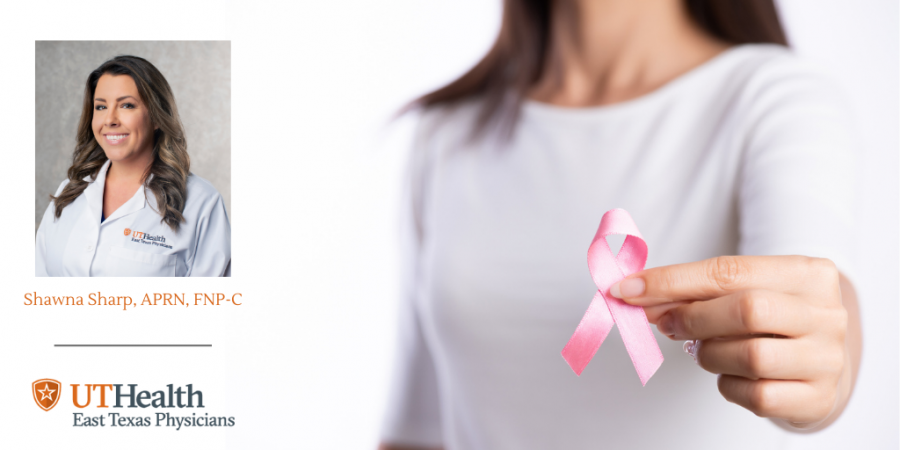
October is Breast Cancer Awareness Month. Cancer is a disease in which the cells in the body grow out of control. Second to skin cancer, breast cancer is the most common cancer in women in the United States. There are nearly 250,000 cases of breast cancer diagnosed in women and 2,300 in men every single year in the U.S. Even with the death rate declining, approximately 42,000 women and 510 men die each year from breast cancer.
A breast consists of three main parts: lobules, ducts and connective tissue. The lobules are the glands that produce milk. The ducts are tubes that carry milk to the nipple. The connective tissue consists of fibrous and fatty tissue and surrounds and holds everything together within the breast. Most breast cancers originate in the ducts or lobules but can develop in any part of the breast.
There are several different kinds of breast cancer, but the most common are invasive ductal carcinoma and invasive lobular carcinoma.
- Invasive ductal carcinoma- The cancer cells grow outside the ducts into other parts of the breast tissue. Invasive cancer cells can also spread, or metastasize, to other parts of the body through blood and lymph vessels.
- Invasive lobular carcinoma- Cancer cells spread from the lobules to the breast tissues that are close by. These invasive cancer cells can also spread, or metastasize, to other parts of the body through blood and lymph vessels.
There are several other less common kinds of breast cancer, such as Paget’s disease, external icon medullary, mucinous and inflammatory breast cancer.
Warning signs of breast cancer:
- A new lump in the breast or underarm (armpit)
- Thickening or swelling of part of the breast
- Irritation or dimpling of breast skin
- Redness or flaky skin in the nipple area or the breast
- Pulling in of the nipple or pain in the nipple area
- Nipple discharge other than breast milk, including blood
- Any change in the size or the shape of the breast
- Pain in any area of the breast
Keep in mind that these symptoms can happen with other conditions that are not cancer. Normal variances in the breast occur with the menstrual cycle, pregnancy, weight changes, medications and age.
If you have any signs or symptoms that worry you, be sure to see your healthcare provider right away.
What you can do
Primary prevention
There is no way to completely prevent breast cancer, but there are a few things you can do to decrease your chances.
- Maintain a healthy weight.
- Exercise 3-5 times per week.
- Do not drink alcohol or limit alcohol intake.
- If you are taking hormone replacement therapy or oral contraceptives (birth control pills), ask your healthcare provider about the risks and find out if it is right for you.
- Breastfeed your children for at least three months, if possible.
- If you have a family history of breast cancer or inherited changes in your BRCA1 and BRCA2 genes, talk to your healthcare provider about other ways to lower your risk.
Staying healthy throughout your life will lower your risk of developing cancer and improve your chances of surviving cancer if it occurs.
Secondary prevention
Finding breast cancer early, when it’s small, has not spread and might be easier to treat, can help prevent deaths from the disease. Getting regular screening tests is the most reliable way to find breast cancer early. Sometimes, breast cancer is found after symptoms appear, but many women with breast cancer have no symptoms. This is why regular breast cancer screening is so important.
Breast cancer screening means checking a woman’s breasts for cancer before there are signs or symptoms of the disease. All women need to be informed by their healthcare provider about the best screening options for them. This could include self-breast exams, clinical breast exams, mammograms, ultrasounds and/or magnetic resonance imaging (MRI) of the breast.
Although breast cancer screening cannot prevent breast cancer, it can help find breast cancer early, when it is likely easier to treat. Talk to your healthcare provider about which breast cancer screening tests are right for you and when you should have them.
Where Can I Get Screened?
You can be screened for breast cancer at a clinic, hospital or doctor’s office. If you want to be screened for breast cancer, call your healthcare provider’s office. They can help you schedule an appointment for screening and/or a wellness exam.
The UT Health East Texas HOPE Cancer Center offers breast care across the region. We also have a traveling mobile mammography unit, making access to breast care easy and convenient.
Most health insurance plans are required to cover screening mammograms every one to two years for women beginning at age 40 with no out-of-pocket cost (like a co-pay, deductible or co-insurance).
Visit our website for more information about locations, services offered and how to schedule an appointment.
To schedule an appointment with Shawna Sharp, APRN, FNP-C at UT Health East Texas Physicians in Henderson, call 903-655-3811.

